Online retailers are expanding their reach to offline shoppers, setting up independent stores and entering department stores, with 13 such new stores slated to open at Lotte Department Store in the first half of 2017.
“Online brands are continuously expanding into offline stores to raise their brand value and to receive real-time feedback from consumers,” Lotte Department Store said in a press release.
Online fashion brands often start out as small enterprises that find their competitive power in affordable pricing and unique styles created by the brands’ buyers. According to Statistics Korea, online sales of apparel and fashion-related items have grown each year by double digits from 6.2 trillion won ($5.48 billion) to 10.2 trillion won between 2013 and 2016.
 |
Customers browse at online brand Imvely’s outlet at Lotte Department Store‘s Young Plaza in Jung-gu, Seoul. (Lotte Department Store) |
As these social media-savvy brands gained traction against traditional fashion houses, they began to open brick-and-mortar outlets as well, first as showrooms then as stores. This helps them to tap into consumers who prefer to see their purchases in person. According to a report from Open Survey last year, 53 percent of consumers say that they purchase their clothes at offline stores.
Lotte Department Store first opened an offline store for Style Nanda in 2012. Currently, there are roughly 100 online brands operating offline outlets at Lotte Department Stores, with sales growing in double digits each year.
In the first half of 2017, the company is preparing to open 13 additional stores at its branches for brands like Imvely, Migun Style and Sappun.
The growth of online brands’ influence has led them to be called “Korean-style SPAs,” referring to the specialty retailers of private-label apparel, or fast fashion brands.
Although most online brands operate by reselling products sourced from fashion wholesalers in areas like the Dongdaemun fashion district, some brands such as Indibrand and Pigment have created their own design and production systems.
This self-contained production capability and the addition of offline stores allows these brands to pit themselves against existing offline Korean fast fashion brands including Mixxo, Spao and 8 Seconds.
Lee Da-yeong, a young casual apparel buyer at Lotte Department Store, opined, “Online retail brands are seeing rapid growth thanks to the advantage of selling small amounts of diverse fashion items that quickly follow trends.”
With this advantage and the clout offered by being included in a well-known department store, some brands, such as Style Nanda and Liphop, have even expanded to offline stores overseas in countries like China and Singapore.
By Won Ho-jung (hjwon@
hjwon@heraldcorp.com">heraldcorp.com)








![[Today’s K-pop] Blackpink’s Jennie, Lisa invited to Coachella as solo acts](http://res.heraldm.com/phpwas/restmb_idxmake.php?idx=644&simg=/content/image/2024/11/21/20241121050099_0.jpg)